Saturday, March 27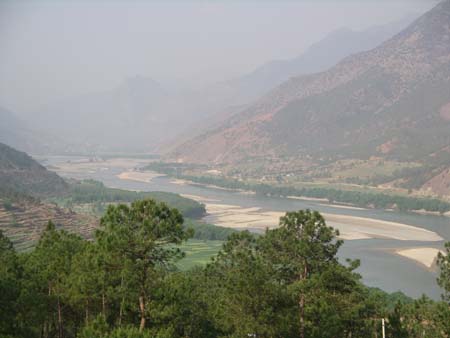
Paula and Steve: Today we made the long but beautiful
drive to Gyanlthang (also called Zhongdian) which literally means "Plateau
of Yaks." Zhongdian is high up on the Tibetan Plateau and we are looking
forward to experiencing the Tibetan culture with plans to visit a famous monastery
and several villages over the next few days. 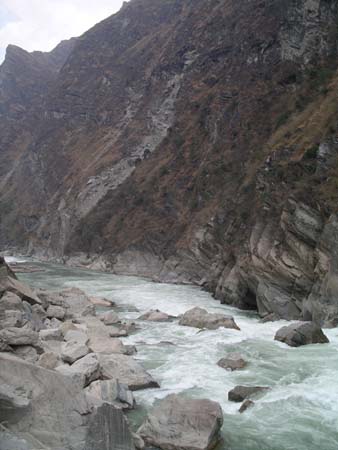
Interestingly, the people here have proclaimed Zhongdian as the "real"
Shangri-la. In James Hilton's 1933 novel, Lost Horizon, he describes a magical
place that apparently strongly resembles Tibet. The people of Zhongdian have
recently (within the past seven years) proclaimed their city to be the actual
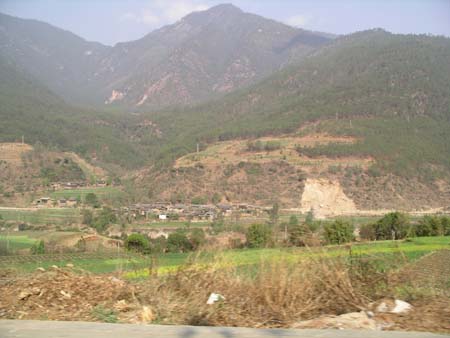 Shangri-la. Ironically, we saw the same claim being made in Lijiang!
Shangri-la. Ironically, we saw the same claim being made in Lijiang!
It took us the better part of the day to make our way through the rugged
mountains, including one 40 kilometer stretch that didn't really deserve to
be called a road. About one hour into the trip, we had our first views of
the Yangzi River. The Yangzi is the longest river i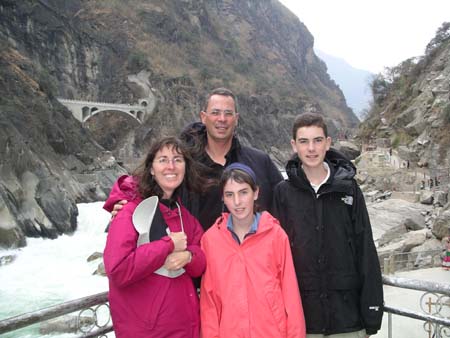 n
China and travels from the Tibetan Plateau through China's heartland supporting
agricultural production and trade. Naxi villages lined the river as we slowly
made our way to Tiger Leaping Gorge.
n
China and travels from the Tibetan Plateau through China's heartland supporting
agricultural production and trade. Naxi villages lined the river as we slowly
made our way to Tiger Leaping Gorge.
This gorge is one of the largest in the world and received its name 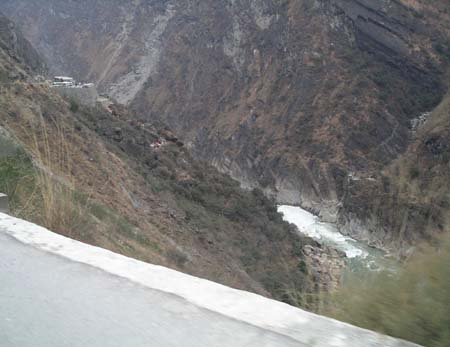 from
an ancient legend regarding tigers that leapt across it. The drive along the
gorge is a bit unnerving - the road is narrow and there are no guard rails
to protect you from the immediate and frighteningly steep drop down to the
river (pictured here on the right). After we arrived, we found that beauty
of the gorge was spoiled by the shops that line the stairs and the constant
badgering by local men offering to carry us up and down (on seats suspended
between long bamboo poles). Combined with the large number of tourists all
fighting for positions to take pictures, this made the gorge s a somewhat
underwhelming experience for us.
from
an ancient legend regarding tigers that leapt across it. The drive along the
gorge is a bit unnerving - the road is narrow and there are no guard rails
to protect you from the immediate and frighteningly steep drop down to the
river (pictured here on the right). After we arrived, we found that beauty
of the gorge was spoiled by the shops that line the stairs and the constant
badgering by local men offering to carry us up and down (on seats suspended
between long bamboo poles). Combined with the large number of tourists all
fighting for positions to take pictures, this made the gorge s a somewhat
underwhelming experience for us.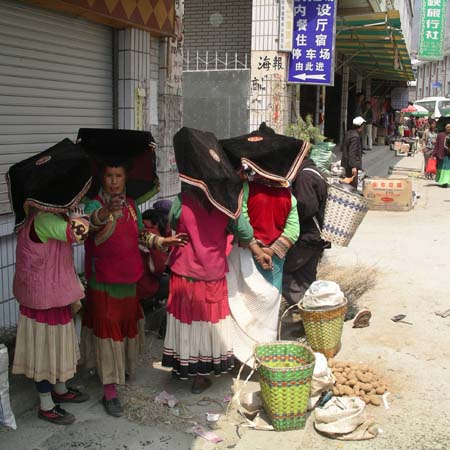
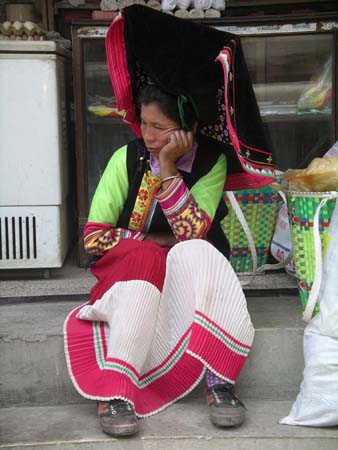 A
local market in the nearby town (of the same name as the gorge) was much more
interesting and here we saw ethnic men and women from the Bai, Black Yi and
Naxi groups. The Black Yi women wear different clothing than the Yi we saw
near Dali, with big black square hats (only worn by married women) and colorful
skirts and jackets. We saw several of these women smoking pipes, and were
told that this is very common. We found the Black Yi to be unwilling to be
photographed unless they were paid. We did manage several pictures, and only
once broke down and gave a woman two Yuan (she wanted five!) in return for
her posing. Our guide told us that the Black Yi have a reputation of being
somewhat lazy and greedy - his explanation for why we had to pay for a picture.
A
local market in the nearby town (of the same name as the gorge) was much more
interesting and here we saw ethnic men and women from the Bai, Black Yi and
Naxi groups. The Black Yi women wear different clothing than the Yi we saw
near Dali, with big black square hats (only worn by married women) and colorful
skirts and jackets. We saw several of these women smoking pipes, and were
told that this is very common. We found the Black Yi to be unwilling to be
photographed unless they were paid. We did manage several pictures, and only
once broke down and gave a woman two Yuan (she wanted five!) in return for
her posing. Our guide told us that the Black Yi have a reputation of being
somewhat lazy and greedy - his explanation for why we had to pay for a picture.
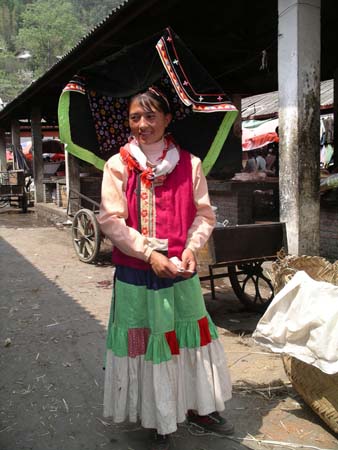
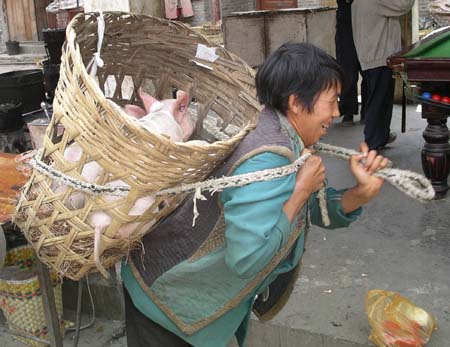 Somewhat
disturbing in the market was a whole area where people were selling dogs,
primarily for food.
Somewhat
disturbing in the market was a whole area where people were selling dogs,
primarily for food.
Back on our way to Zhongdian we asked to stop at a Black Yi village so that
we could see how they live. Our guide, Lee, explained to us that the Black
Yi live mostly in the mountains and their villages are often accessible only
by paths wide enough for walking or donkeys. Fortunately, we passed seve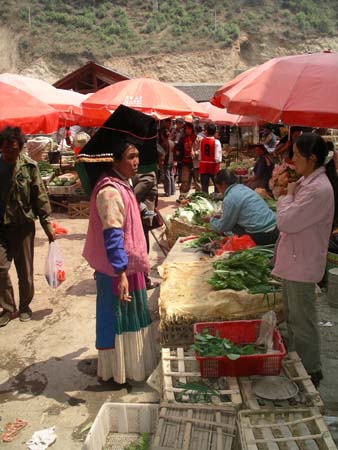 ral
of the more accessible villages before reaching Zhongdian and took the opportunity
to stop in one.
ral
of the more accessible villages before reaching Zhongdian and took the opportunity
to stop in one.
The Black Yi used to enslave another group called the White Yi but this was
outlawed in 1949 by the Communist Party. These groups now live together peacefully.
The village we visited is small with only 30 families, but this is actually
larger than most. The homes are quite 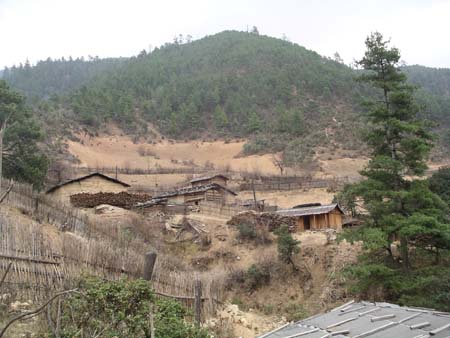 different
than the other villages we have visited in China, reminding us in many ways
of the mountain villages that we saw in Laos. The homes are simple wood or
dirt walled structures without windows. An open fire in the middle of the
dark homes is used for cooking and warmth. The homes contain only a few pots
for cooking, some tattered clothes and a few farm tools. .
different
than the other villages we have visited in China, reminding us in many ways
of the mountain villages that we saw in Laos. The homes are simple wood or
dirt walled structures without windows. An open fire in the middle of the
dark homes is used for cooking and warmth. The homes contain only a few pots
for cooking, some tattered clothes and a few farm tools. .
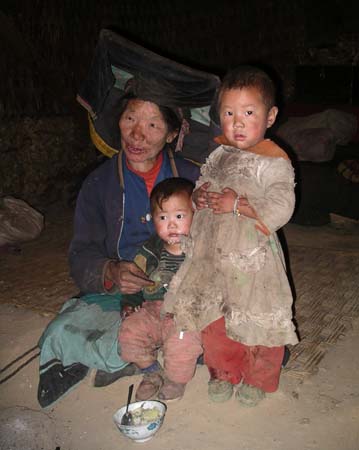
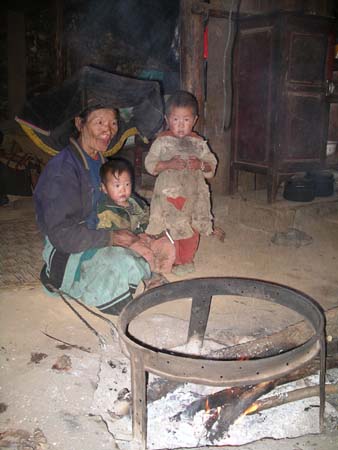 We
knocked on a door and visited with a grandmother and her two small grandchildren
as she was feeding them lunch. Typical of the hospitality we always seem to
encounter in these situations, she asked if we were hungry and offered to
feed us even though it was clear that the family doesn't have much food. There
was no furniture in the home (the family sleeps and eats on the floor), and
the woman actually apologized to us for not having any chairs to offer us
for sitting. The Yi represent some of the poorest people in China because
the soil in the areas where they live is usually very rocky and they people
are forced to grow mostly potatoes and raise livestock.
We
knocked on a door and visited with a grandmother and her two small grandchildren
as she was feeding them lunch. Typical of the hospitality we always seem to
encounter in these situations, she asked if we were hungry and offered to
feed us even though it was clear that the family doesn't have much food. There
was no furniture in the home (the family sleeps and eats on the floor), and
the woman actually apologized to us for not having any chairs to offer us
for sitting. The Yi represent some of the poorest people in China because
the soil in the areas where they live is usually very rocky and they people
are forced to grow mostly potatoes and raise livestock. 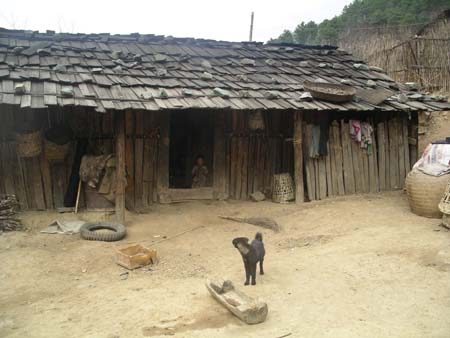
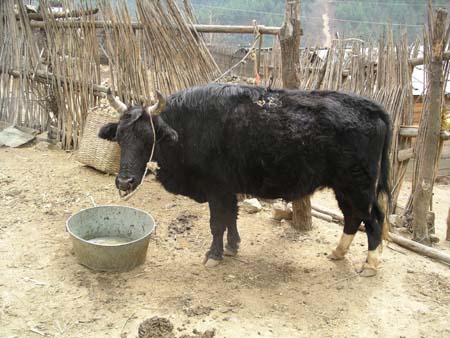 We
met our first zu (a cross between a yak and cow) and saw many dogs being raised
for meat. The villagers also maintain several pigs and chickens, and the animals
are all kept in pins made from bamboo.
We
met our first zu (a cross between a yak and cow) and saw many dogs being raised
for meat. The villagers also maintain several pigs and chickens, and the animals
are all kept in pins made from bamboo. 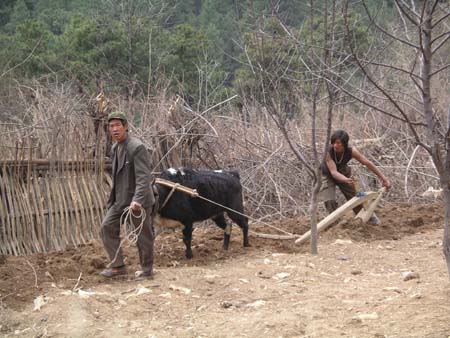
We spoke with one man who told us that the government gives the Yi rice in
return for planting trees and grass on the mountainsides. Our guide explained
that this ethnic group used to move their entire village every three years,
selecting a new area to deforest and 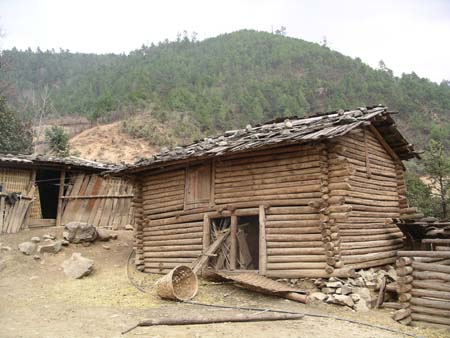 cultivate.
The government is now providing them food in return for their help in reforesting
the area.
cultivate.
The government is now providing them food in return for their help in reforesting
the area.
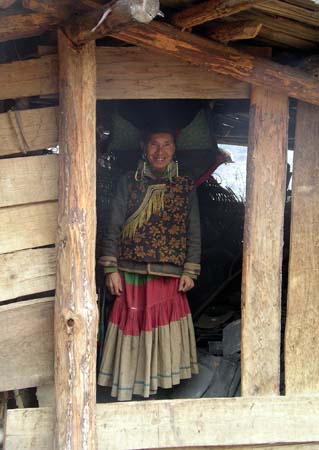
As we left, we watched several men plowing a field with their zu. We also
found it interesting to see women as well as men smoking pipes and loved the
colorful dress and hats worn by the women. Like the Naxi, the Yi have their
own language and religion. 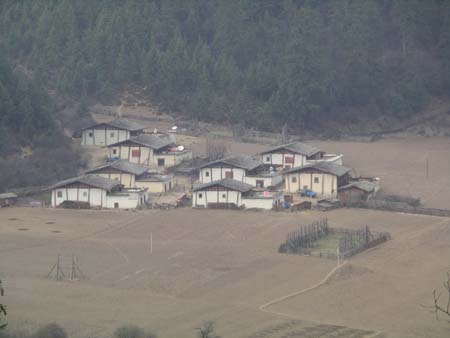
As we got closer to Zhongdian, we began to see Tibetan villages. These looked
distinctive and actually reminded us of some the homes we had seen in villages
in Southern Spain. The homes are larger than those in any of the other ethnic
villages and Lee told us that the Tibetans are relatively wealthy compared
to other minorities. We also saw hundreds of yak and zu grazing and large
white stupas (temples for praying) throughout the countryside. 
We arrived to our hotel late afternoon and as expected found the air crisp and very cool (about 45 degree Fahrenheit). After having a cup of warm tea in the lobby, we were taken to our rooms decorated in colorful Tibetan style. The kids loved the platform beds (complete with electric blankets) and burning incense.
This evening we took a short walk through Zhongdian's old city before dinner. The city is currently undergoing major construction, funded by the government. Similar to what has been accomplished in Dali and Lijiang, China is looking to create a restored city here that will attract even greater numbers of tourists. A huge gate is being constructed at the entrance to the old city. We expect that when the work is complete, Zhongdian will contain scores of shops and restaurants, and will attract the same busloads of tourists that we saw in Dali and Lijiang.
For dinner we ate at a small restaurant that's actually owned by Susan, our guide from Lijiang (that's her "American" name). We enjoyed some new foods, including a wonderful fried pork dish.
Tomorrow we are traveling to a small village called Benzilan, on the border with Tibet. There we have arranged to spend time with a Tibetan family, visit a school, and explore the village.
